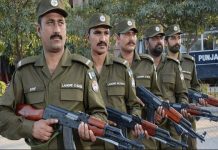MUHAMMAD TAHIR
Punjab’s childhood and traditional games lost in the busy city life. Razia Bibi and her husband Abdul Razzaq , a local citizen of Faisalabad City shared their old days stories. The brokenhearted family memorizing their childhood, the local games and sports they played, said we don’t understand, where to start our stories of good old time.
This is our great appetency to watch our grandchildren playing these sports of our heritage. This will also help us to sobs of our childhood memories can be lessened.
Paved floors of homes and harsh routine of city life is swallowing these sports of our rich culture. We will be obsessed with remembering the sports of our childhood. Around six seven decades ago Punjab is full of joy and colors, Children played many games at their home and in the peaceful ambiance of the countryside, other indigenous games were also played with enthusiasm.
But children of today are very busy in their mobile and computer activities, Beautiful bicycles are not the only opportunity they have now. It’s hard for modern children to find the time for old days sports that over time only left in the reminiscence of their grandparents.
The reminding the most famous sports of these days like Goli Danda, ChupanChupai, Rasi Phalangna, KoklaChpaki, JhulaJhulna, LatuChalana, KanchayAkhrootkhelna and playing with homemade GudayGudian. Abdul Razzaq said I also I miss the raw courtyard and the mud walls without doors, Kabaddi was once a once a popular sports. There used to be very famous kabaddi players in our time, Their amazing strength and exercise was applied to the annual festivals. If a player fails it would have a bad effect on his reputation so he had to work hard again. Players get nothing in cash but respect and fame for all this in all the villages around the Punjab. Kabaddi is still playing, but it is no longer popular among young men, they turn red with youthful enthusiasm instead of consciousness.
There will probably be many more games like these, but there is no one left to tell about them. The names of their creators are unknown, no one to explain the rules and regulations of these simple sports. In the villages, these games were first played by older children and young children learned the rules of these games from them. There would be some such talk during these games which had to be memorized and repeated. The children memorized the words related to the game along with the game. Most of the games were attributed to one or the other. The process continued from generation to generation.
Gulli Danda can still be seen in the villages. This game is about two feet long stick other than wood, a five-inch wooden gully is bounced and hit. The gulli is sharpened on both sides so it can bounce in the air with a slight hit.
City resident Razia Bibi said, girls of our age played games like Jhula Jhulna, Rasi Kudna, Guday Gudionkay khel, which are now extinct. In our time, both boys and girls could play together. And the night life of the village was also very beautiful. These games were at their peak in the moonlight. Chupan Chupai and Lukan Mitti were very famous among Children and Teens.
She says this is a spring and summer game. The children hide in different places in a mansion, the other team is looking for them. In order to bring the children together, one child chants and repeats aloud,
Golra Chupaki is also very famous. The children sit in a circle; no one is allowed to look back or give a signal. A child makes a wipe out of cloth and revolves around the circle. Meanwhile, he secretly puts the wipe behind someone. If he finds out, then fine, otherwise by completing the circle the child picks up the whip and starts beating him. If he found out, he would pick up the one who had it and beat him. The boy also chants songs aloud during this time.
But now these games have been replaced by the Internet and computer games. The biggest disadvantage of these games is that children lose contact with each other. Urban and rural children are now deprived of the blessing of communication. The tragedy is that on the one hand, we are losing cultural values and doing nothing to preserve them.

















